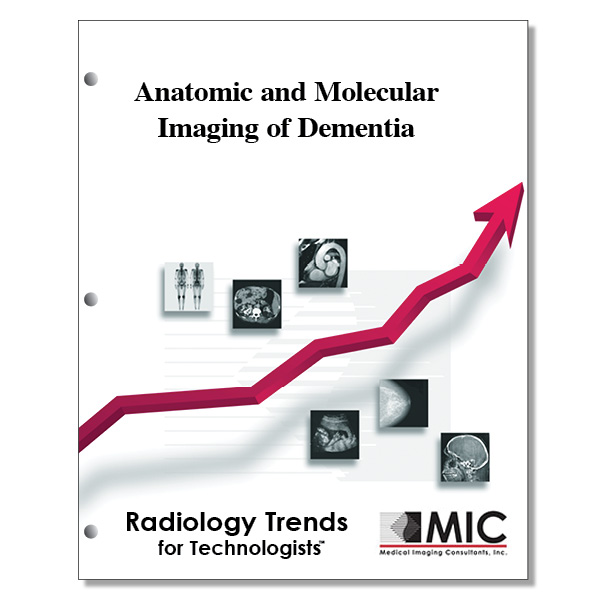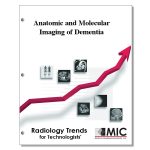

Anatomic and Molecular Imaging of Dementia
A presentation of the multiple imaging modalities that are essential in the multidisciplinary management of patients with neurodegenerative diseases.
Course ID: Q00622 Category: Radiology Trends for Technologists Modalities: CT, MRI, Nuclear Medicine, PET2.5 |
Satisfaction Guarantee |
$29.00
- Targeted CE
- Outline
- Objectives
Targeted CE per ARRT’s Discipline, Category, and Subcategory classification:
[Note: Discipline-specific Targeted CE credits may be less than the total Category A credits approved for this course.]
Magnetic Resonance Imaging: 1.00
Procedures: 1.00
Neurological: 1.00
Nuclear Medicine Technology: 2.00
Procedures: 2.00
Other Imaging Procedures: 2.00
Registered Radiologist Assistant: 0.75
Procedures: 0.75
Neurological, Vascular, and Lymphatic Sections: 0.75
Outline
- Introduction
- Structural Imaging
- Molecular Imaging
- FDG PET
- Amyloid-β PET
- 123I-Ioflupane SPECT
- τ-based PET
- Computer-Assisted Quantitative Evaluation
- Pathophysiology of Neurodegenerative Diseases
- Alzheimer Disease
- Dementia with Lewy Bodies
- Frontotemporal Lobar Degeneration
- Vascular Dementia
- Other Dementing Disorders
- Patient Workup, Algorithm, and Recommendations
- Conclusion
Objectives
Upon completion of this course, students will:
- know how definitive objective diagnosis of neurodegenerative disease can currently be made
- identify the traditional role of neuroimaging in dementia
- be familiar with the various areas of the brain that are important to evaluate during structural imaging assessment
- be familiar with the reasons for using the various MRI sequences for evaluating patients with suspected dementia
- know the usefulness of FDG PET for brain imaging
- know SNMMI recommendations for 18F-FDG use for neurologic PET imaging
- be familiar with the location and orientation of the recommended T2-weighted MR images for the assessment of the visual rating system for mesial temporal atrophy scoring
- know the area of the brain that, when spared, is a classic finding of Alzheimer disease
- know the various radiopharmaceuticals used in beta-amyloid PET imaging and their trade names
- know the area of the brain that is typically used as an internal control for uptake comparison when evaluating cortical uptake of beta-amyloid PET agents
- be familiar with the SNMMI recommendations for 18F-amyloid PET imaging and its multiple radiopharmaceutical options
- know the target radiopharmaceutical of dopamine transporter which allows visualization of the active synapses in the corpus striatum
- understand the cause and appearance of DaTScan in SPECT imaging of patients with parkinsonian diseases
- understand the potential effect of 123I-ioflupane on the thyroid gland and what can be done to alleviate these concerns
- be familiar with some aspects of t-based PET radiopharmaceuticals
- know the type(s) of abnormal t protein accumulated by diseases that demonstrate the most radiotracer accumulation
- know how quantitative measurements can currently be performed for neurologic PET studies, even though extensive data required to standardize uptake values in neurologic PET imaging does not yet exist
- know the relative quantitative value that reflects the number of standard deviations of abnormal uptake from that of a normal distribution of uptake
- be familiar with the neurodegenerative diseases of the tauopathies category
- understand the pros and cons of utilizing beta-amyloid PET imaging in the evaluation of a patient for Alzheimer disease
- know the entities that make up the alpha-synucleinophathy subgroup of neurodegenerative diseases
- be familiar with how imaging of alpha-synucleinopathies can currently be performed clinically
- know how Alzheimer disease is characterized histopathologically
- be familiar with the t protein deposition in the various stages of the Braak staging system
- be familiar with the diagnostic criteria for Alzheimer disease diagnosis
- be familiar with the pattern of atrophic changes in Alzheimer disease on structural MRI
- know the typical areas of hypometabolic activity in Alzheimer disease at 18F-FDG PET imaging
- understand the value of negative amyloid imaging agent uptake on the assessment for Alzheimer disease
- understand the progression of Lewy bodies according to the Braak staging system for Lewy body aggregation
- understand the differences between the progression of clinical symptoms among the various neurodegenerative diseases
- know how to differentiate DLB from Alzheimer disease at 18F-FDG PET imaging
- be familiar with the grouping of similar tauopathies described by the term “frontotemporal lobar degeneration”
- know how to differentiate FTLDs from DLB and Alzheimer disease at 18F-FDG PET imaging
- be familiar with the typical vascular insults found in vascular dementia patients at MRI
- be familiar with the imaging appearance of various neurologic processes for neurodegenerative diseases
